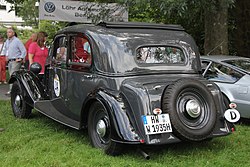Wanderer W 22
| walker | |
|---|---|
|
Wanderer W 240 (1935)
|
|
| W 22 / W 240 / W 40 | |
| Production period: | 1933-1938 |
| Class : | Middle class |
| Body versions : | Touring car , limousine , Pullman limousine , convertible |
| Engines: |
Petrol engines : 2.0 liters (29 kW) |
| Length: | 4500 mm |
| Width: | 1670 mm |
| Height: | 1650 mm |
| Wheelbase : | 3000 mm |
| Empty weight : | 1250-1310 kg |
The Wanderer W 22 is a car of the middle class of the brand Wanderer 2-liter six-cylinder engine and rear-wheel drive . The Auto Union presented him in 1933 as a larger version of the Wanderer W 21 with 1.7 liter engine in front. Both were developed as Porsche Type 7 in Ferdinand Porsche's design office in Stuttgart. The W 22 was on the market as a four-door sedan and two-door convertible (four windows). In addition, there was the four-seater touring car from 1934 . By 1935, the Auto-Union plant in Siegmar near Chemnitz had produced 5,355 vehicles, including 2,010 chassis, which glasses in Dresden provided with the convertible body,
The W 22 has the same engine as its predecessor W 20 (8/40 hp) , but an improved low-frame chassis with a rigid front axle and torsion bar suspension on the same wheelbase ; At the rear a "swing axle" ( pendulum axle ) with transverse spring is installed, which Porsche had designed based on its designs at Steyr . Instead of the mechanical cable brake of the W 20, there was a hydraulically actuated "oil pressure brake" from ATE (license Lockheed ).
The overhead in - line engine with side camshaft ( spur gear drive ) developed by Porsche in 1931 has a displacement of 2 liters and an output of 40 hp. The rear wheels are driven via an unsynchronized four-speed gearbox with a shift lever in the middle of the car.
In 1935 the name of the same car was Wanderer W 240 . The limousine only had four windows, the convertible only two.
Auto Union presented the successor Wanderer W 40 with front independent suspension ( double wishbone with transverse spring) but otherwise identical in construction; The touring car was discontinued in 1937.
Technical specifications
| Type | W 22 | W 240 | W 40 |
| Construction period | 1933-1934 | 1935 | 1936-1938 |
| Superstructures | T4, L4, PL4, Cb2 | T4, L4, Cb2 | T4, L4, Cb2 |
| engine | 6 cyl. Row 4-stroke | 6 cyl. Row 4-stroke | 6 cyl. Row 4-stroke |
| Valves | top steering (OHV) | top steering (OHV) | top steering (OHV) |
| Bore × stroke | 70 mm × 85 mm | 70 mm × 85 mm | 70 mm × 85 mm |
| Displacement | 1950 cc | 1950 cc | 1950 cc |
| Horsepower) | 40 | 40 | 40 |
| Power kW) | 29 | 29 | 29 |
| consumption | 13 l / 100 km | 13 l / 100 km | 13 l / 100 km |
| Top speed | 100 km / h | 100 km / h | 100 km / h |
| Empty weight | 1250-1310 kg | 1250-1310 kg | 1250-1310 kg |
| Perm. total weight | 1700-1760 kg | 1700-1760 kg | 1700-1760 kg |
| Electrics | 12 volts | 12 volts | 12 volts |
| length | 4500 mm | 4500 mm | 4500 mm |
| width | 1670 mm | 1670 mm | 1670 mm |
| height | 1650 mm | 1650 mm | 1650 mm |
| wheelbase | 3000 mm | 3000 mm | 3000 mm |
| Front / rear track | 1350 mm / 1350 mm | 1350 mm / 1350 mm | 1350 mm / 1350 mm |
| Turning circle | 12 m | 12 m | 12 m |
- T4 = 4-seater touring car
- L4 = 4-door sedan
- PL4 = 4-door Pullman - Limousine
- Cb2 = 2-door convertible
literature
- Werner Oswald : German Cars 1920–1945 . Motorbuch Verlag, Stuttgart 1996, 10th edition, ISBN 3-87943-519-7
Web links
- www.audi.de - Evolution of the models: 1932–1945 Wanderer W 22 Cabriolet, 1933

